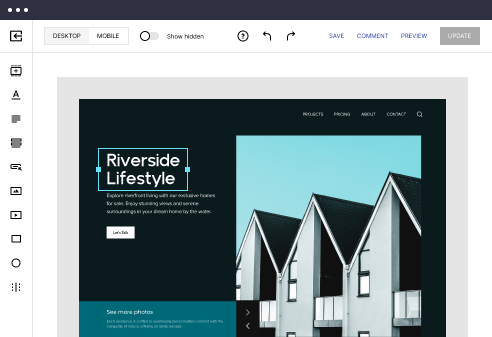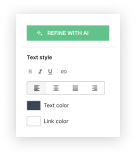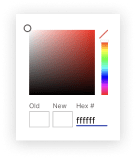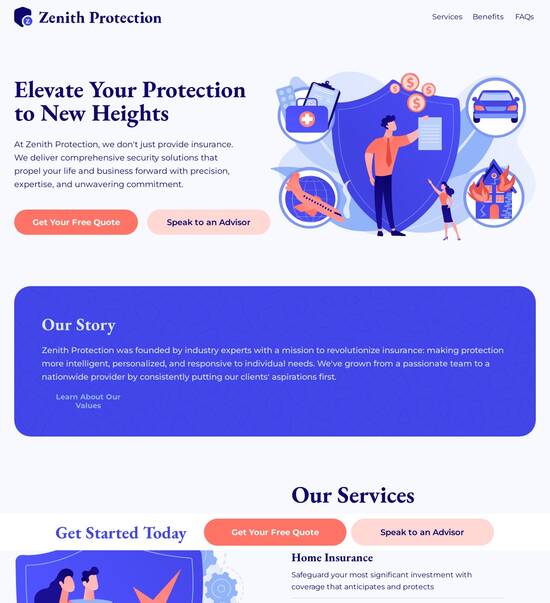
A perfect ruby HTML page template
Use TemplateAbout template
Manage and personalize ruby HTML page according to your needs. Envision, design, and innovate today.
Recommended templates
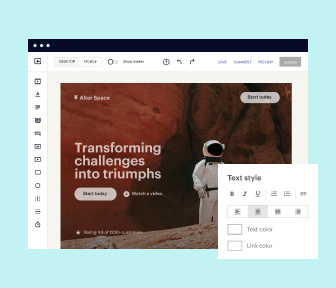
Easy to build without coding
With the intuitive drag-and-drop builder, anyone on your team can create high-converting pages without any knowledge of code or design. Make enhancements to your landing page with custom widgets using Javascript, HTML/CSS, or third-party scripts.
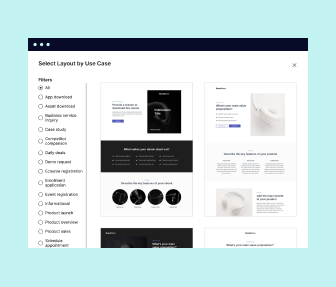
Multiple layouts for any industry and goal
Select from 500+ landing page layouts built to boost conversions across industry-specific scenarios. Customize them by adjusting fonts, adding images, and generating on-brand content with the AI assistant. Quickly scale with Instablocks® and Global Blocks that you can save, reuse, and update globally.
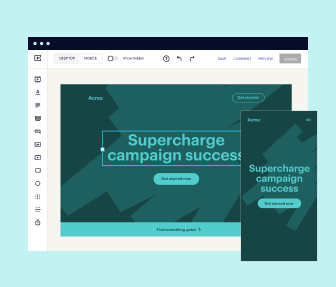
Loads fast and looks polished on any device
Every template is responsive, which means they present professionally on any device and load blazingly fast with our Thor Render Engine. You can also power them up with Google AMP technology to deliver an unparalleled mobile experience and drive higher conversions.
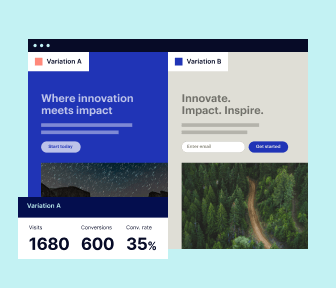
Robust analytics & experimentation
Get real-time updates and reporting across all your devices, showing the number of visitors, conversions, cost-per-visitor, and cost-per-lead. Launch AI-powered experiments, run A/B tests, and use heatmaps to analyze user behavior, then optimize your landing page to maximize conversions.

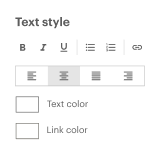
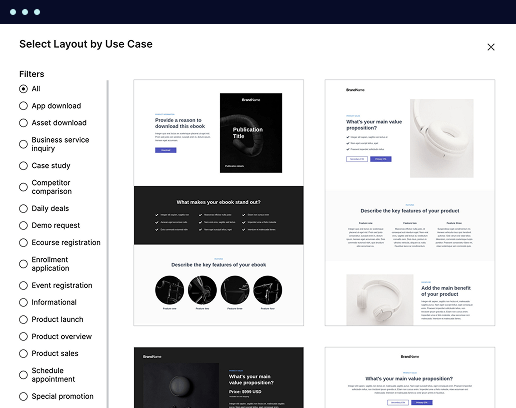
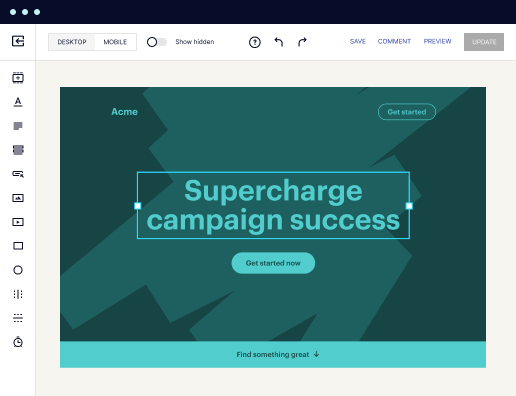

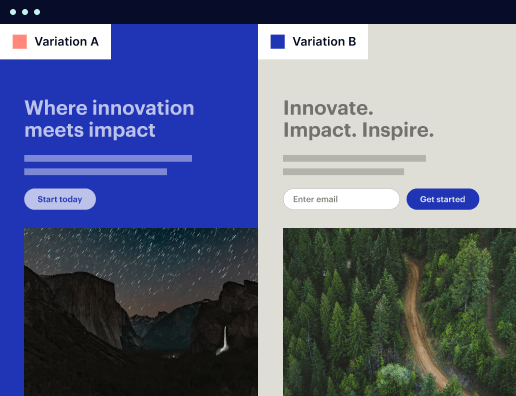

Easy to build without coding
With the intuitive drag-and-drop builder, anyone on your team can create high-converting pages without any knowledge of code or design. Make enhancements to your landing page with custom widgets using Javascript, HTML/CSS, or third-party scripts.
Multiple layouts for any industry and goal
Select from 500+ landing page layouts built to boost conversions across industry-specific scenarios. Customize them by adjusting fonts, adding images, and generating on-brand content with the AI assistant. Quickly scale with Instablocks® and Global Blocks that you can save, reuse, and update globally.
Loads fast and looks polished on any device
Every template is responsive, which means they present professionally on any device and load blazingly fast with our Thor Render Engine.
Robust analytics & experimentation
Get real-time updates and reporting across all your devices, showing the number of visitors, conversions, cost-per-visitor, and cost-per-lead. Launch AI-powered experiments, run A/B tests, and use heatmaps to analyze user behavior, then optimize your landing page to maximize conversions.
All the features you need to build ruby template
Explore more featuresLearn how to build erb template
Frequently asked questions about puppet erb template
Leading the way in building high-performing landing pages





A step-by-step guide for using Instapage effectively
Instapage is a powerful all-in-one landing page and conversion rate optimization (CRO) platform that can significantly boost the performance of digital marketing campaigns. This step-by-step guide will help you leverage its features, from creating landing pages to optimizing them for conversions, tailored specifically for marketing professionals across various industries in the USA.
Understanding landing page essentials
Before diving into page creation, it’s essential to understand what makes a landing page effective. A focused landing page often features a compelling call-to-action (CTA), relevant content, and an eye-catching design. Without these key elements, your conversions could suffer. Here are the fundamental components that each landing page should include:
- A clear and concise headline: Captures visitor attention instantly.
- Engaging visuals: High-quality images and videos enhance user engagement.
- Prominent CTA: Directs visitors toward desired actions, such as signing up or making a purchase.
Creating your first landing page
With Instapage, building a landing page is intuitive. Begin by selecting one of the 100+ high-converting templates available. Each template is customizable, allowing you to tailor it to your specific needs.
- Choose a template: Select one that's suitable for your industry and campaign goals.
- Customize the layout: Use Instablocks to rearrange sections and add relevant elements.
- Add content: Write persuasive copy and include visuals that resonate with your target audience.
Optimizing for higher conversions
Once your landing page is live, optimization becomes key to maximizing conversions. Use Instapage’s built-in analytics and A/B testing features to understand visitor behavior and adjust your strategies accordingly.
- Implement heatmaps: Gain insights into which areas of your page attract the most attention.
- Conduct A/B tests: Experiment with different headlines, images, or CTAs to see what drives the best results.
- Analyze performance: Regularly review your page’s analytics to identify areas for improvement.
In conclusion, the integration of effective templates, powerful optimization tools, and user-friendly collaboration features makes Instapage the ideal platform for marketers looking to enhance their digital strategies.
Ready to take your campaigns to the next level? Start utilizing Instapage today to create high-performance landing pages that convert.
People also ask about Ruby HTML page template
Unveiling Ruby HTML Page Templates: A Deep Dive into Innovative Web Development
Understanding Ruby HTML page templates
Ruby HTML page templates combine the flexibility of Ruby programming with the structure of HTML to facilitate dynamic web page creation. They allow developers to insert Ruby code directly into HTML, enabling the rendering of variable content such as user inputs and database data. Ruby on Rails, a popular framework built on Ruby, enhances this capability by providing conventions and tools specifically designed for rapid web application development.
The integration of HTML with Ruby templates provides a powerful approach to web development, where developers can create rich user interfaces using familiar HTML syntax while injecting Ruby logic for dynamic behavior. This is primarily achieved through ERB, or Embedded Ruby, which acts as the engine that processes Ruby code within HTML files, transforming them into fully functional web pages.
Technology stack behind Ruby HTML templates
The core technologies that form the foundation of Ruby HTML page templates include Ruby itself, a high-level programming language known for its simplicity and productivity. Accompanying Ruby are HTML and CSS, which structure and style the web pages. JavaScript is often used alongside these technologies to introduce interactive elements, enhancing user engagement and experience.
Ruby on Rails is the most widely recognized framework that utilizes Ruby for web development, providing a robust structure to manage web applications efficiently. For lighter needs, Sinatra serves as an alternative framework that allows for quick application creation without the overhead of full Rails paradigms. Additionally, data management is handled effectively through ActiveRecord in Rails, making CRUD operations intuitive and straightforward. For projects that require flexibility in data storage, NoSQL options like MongoDB can also be leveraged with Ruby applications.
The benefits of using Ruby HTML page templates
One of the foremost benefits of Ruby HTML page templates is the rapid development and prototyping capabilities they offer. Developers can streamline their workflow and quickly iterate on design ideas. Utilizing pre-built templates, they can deploy web applications in a fraction of the time it would take to build from scratch. This level of efficiency is critical in today’s fast-paced development environments.
Code reusability and modularity, which is facilitated by the DRY (Don’t Repeat Yourself) principle. This encourages developers to create reusable components and partials that can be easily included in various pages.
Enhanced readability and maintenance, thanks to the cleaner separation of logic and presentation. This makes it easier for teams to collaborate and manage codebases, while tools for version control further aid in collaborative development.
Exploring use cases: Ruby HTML page templates in action
Ruby HTML page templates are utilized across various real-world applications, showcasing their versatility and effectiveness. E-commerce platforms often adopt these templates to manage complex product listings, user accounts, and checkout systems, allowing businesses to focus on their product offerings while keeping the tech stack manageable. Similarly, content management systems powered by Ruby on Rails provide user-friendly interfaces for content creators, allowing for the efficient management of website content.
A notable case study involves a startup that utilized Ruby templates to transition from concept to a fully functional landing page rapidly. Through the ups and downs of development, they learned valuable lessons about optimizing performance and enhancing user experience. The experience highlights not only the speed of development using Ruby HTML templates but also the importance of ongoing adjustments based on user feedback.
Diving into the structure and format of Ruby HTML templates
The typical components of a Ruby page template include layout files, which define the overall structure of the page, and views that present specific content. Partials and helpers are also essential for effective organization and functionality, allowing developers to break down their templates into manageable pieces. This modular approach not only improves the clarity of the code but also enhances the ease of updates and changes.
When organizing files and directories, adhering to Rails' conventions can dramatically improve project collaboration and maintenance. A simple example of creating a Ruby HTML page template might include writing an ERB file. This can involve embedding Ruby code to display dynamic information like user profiles or articles pulled from a database.
Addressing common questions: Ruby HTML page templates Q&A
Many developers new to the scene often wonder how Ruby compares to other templating languages, such as PHP or Python. Ruby's main advantage lies in its expressive syntax and supportive community, which many find easier to navigate than alternatives. However, challenges may arise for those unfamiliar with the conventions of Ruby on Rails, necessitating a learning curve.
One common challenge is understanding the intricacies of embedded Ruby syntax within HTML, which can be a shift for developers coming from purely front-end backgrounds.
Beginners might find it beneficial to focus on building small projects initially, gradually increasing complexity as they become more familiar with the Ruby ecosystem.
The role of communities and collectives in Ruby development
The strength of Ruby development lies in its community. Engaging with Ruby on Rails and HTML communities through online forums, discussion boards, and local meetups can significantly enhance a developer's learning experience. These interactions foster knowledge sharing and provide opportunities for mentorship and networking that can prove invaluable for growth.
Engaging in open source projects is another way developers can contribute to and grow within the Ruby ecosystem. By collaborating on templates and tools, they expand their skills while simultaneously aiding others. This collaborative spirit nurtures innovation and keeps the framework vibrant and responsive to changing web development needs.
Teams and collaboration: Working effectively with Ruby templates
For teams working on Ruby HTML templates, following best practices for collaboration can help streamline the development process. Establishing a structured code review process encourages transparent feedback loops that can significantly improve code quality. Implementing version control systems such as Git allows teams to manage code changes efficiently, resolving conflicts and maintaining project integrity as development progresses.
Additionally, adopting Agile development methodologies enables teams to focus on iterative improvements. By organizing work into sprints, developers can concentrate on specific features or tasks, allowing for rapid adjustments based on stakeholder feedback or testing outcomes. This approach ultimately leads to more refined and user-centered web applications.
Innovations in technologies affecting Ruby HTML templates
In the realm of web development, trends are constantly evolving, and Ruby is no exception. The rise of Jamstack architecture and headless CMS solutions has introduced new paradigms for how developers can utilize Ruby templates. These technologies separate the frontend from the backend, offering enhanced performance and flexibility.
Progressive Web Applications (PWAs) are emerging as a powerful use case for Ruby HTML templates, allowing developers to create fast, reliable, and engaging web apps.
Looking ahead, it's reasonable to anticipate further advancements in Ruby tools and frameworks that enhance the way developers create and manage web applications.
The differences between Ruby HTML templates and other web technologies
When comparing Ruby HTML templates to those based on PHP, Python, or JavaScript, several key differences emerge. Ruby is often praised for its elegant syntax and focus on developer happiness, qualities that many find appealing compared to more verbose alternatives. Moreover, Ruby integrates seamlessly with Rails, offering a rich set of features for building web applications quickly.
Additionally, Ruby templates can be highly adaptable across different platforms, enabling developers to leverage their skills in various environments. This adaptability is essential for businesses that operate in a constantly shifting digital landscape, providing them with the agility needed to remain competitive.
Collecting knowledge: Resources for learning and development
For those looking to further their knowledge of Ruby HTML templates, numerous resources are available. Online courses and tutorials can guide new developers through the essentials, while books and e-books on Ruby programming offer deeper insights into advanced concepts.
Interactive platforms like GitHub are exceptional for engaging with the Ruby community and participating in projects to build practical skills.
Attending workshops and webinars serves as an effective way to learn from experienced developers and foster connections within the community.
Final thoughts: The growing influence of Ruby HTML templates in modern development
As Ruby continues to shape the landscape of web development, its HTML templates play an integral role in creating responsive and dynamic applications. The impact of Ruby on the current web ecosystem cannot be overstated, as it empowers developers to build applications that meet diverse user needs while being easy to maintain and scale.
Looking ahead, the trends and innovations surrounding Ruby HTML templates promise to foster exciting developments in web design. As technology evolves, it’s crucial for developers to stay informed and adaptable to leverage Ruby’s full potential, ensuring that they are well-equipped to create the next generation of web applications.
Ready to skyrocket conversions?
Supercharge your ad campaigns with high-performing landing pages
Get started